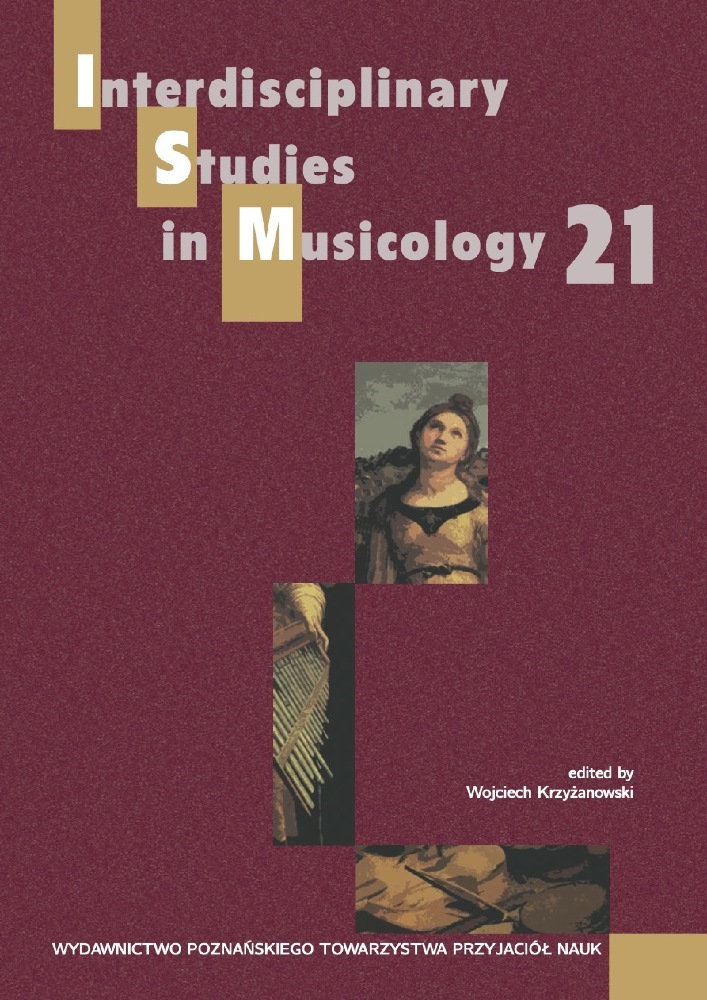Abstract
The aim of the article is to look at serious musical leisure activities in selected places in Wroclaw, in order to explain their significant contribution to making the capital of lower Silesia a creative city. Taking the perspective of research on music scenes and leisure studies, the author tries to demonstrate that the music scene in Wroclaw, although it didn’t develop its original sound, functions in a very effective way, providing a space for personal development, shaping the identity of individuals and the entire city. The discussed places not only serve as a physical space for a performance but primarily are communities based on internal and external cooperation. They are real “meeting places,” as the promotional slogan of Wroclaw says, for audiences and performers, amateurs, and professionals alike. The article is based on research on the Wroclaw music scene conducted since 2019. live performances that took place before the COvID-19 pandemic and between subsequent lockdowns were taken into account.
References
Bennett, A., Peterson, R. (2004). Introducing Music Scenes, In A. bennett, R. Peterson (Eds.), Music Scenes: Local, Translocal, and Virtual (pp. 1–16). Nashville: Vanderbilt University Press.
Brabazon, T. (2012). Popular music. Topics, trends & trajectories. London: SAGE Publications ltd.
Connell, J., Gibson, C. (2003). Sound tracks. Popular music, identity and place. london, NewYork: Routledge.
Dziuban, Z. (2014). Doświadczenie [Experience]. In E. Rewers (Ed.), Kulturowe studia miejskie [Urban cultural studies] (pp. 139–186). Warsaw: Narodowe Centrum Kultury.
Finnegan, R. (1989). The Hidden Musicians: Music-Making in an English Town. Middletown: Wesleyan University Press.
Fischer-Lichte, E. (2008). Estetyka performatywności [Aesthetics of performance]. Cracow: Księgarnia Akademicka.
Florida, R. (2010). Narodziny klasy kreatywnej [The Rise of the Creative Class]. Warszawa: Narodowe Centrum Kultury.
Frith, S. (1987). Towards an Aesthetic of Popular Music. In R. leppert, S. McClary (Eds.), Music and Society: The Politics of Composition, Performance and Reception (pp. 133–150). Cambridge: Cambridge University Press.
Hallam, S., Creech, A., varvarigou, M. (2017). Well-being and Music leisure Activities through the lifespan, In R. Mantie, G. D. Smith (Eds.), The Oxford Handbook of Music Making and Leisure (pp. 31–60). Oxford: Oxford University Press.
Kaplan, M. (1997). Sociology and Music Education: Issues and Connections. In R. Rideout (Ed.), On the Sociology of Music Education (pp. 55–64). Norman: University of Oklahoma Press.
Kaufman Shelemay, K. (2011), Musical Communities: Rethinking the Collective in Music. Journal of the American Musicological Society 64 (2): 363–364.
Kardas, M. (2012). Klasa kreatywna a wspieranie innowacyjności [Creative class and supporting innovation]. In K. Klincewicz (Ed.), Klasa kreatywna w Polsce. Technologia, talent i tolerancja jako źródła rozwoju regionalnego [Creative class in Poland. Technology, talent and tolerance as sources of regional development] (pp. 28–37). Warsaw: Wydawnictwo Naukowe Wydziału Zarządzania Uniwersytetu Warszawskiego.
Kędzior, J. (2019). Praktyki kulturalne studentów w czasie wolnym [Student cultural practices in leisure time]. In J. Kędzior (Ed.), Praktyki komunikacyjne [Communication practices] (pp. 56–80). Wroclaw: Instytut Pedagogiki Uniwersytetu Wrocławskiego.
Kopel, A. (2007). Klasa kreatywna jako czynnik rozwoju miast [Creative class as a factor of urban development]. Zeszyty Naukowe Wyższej Szkoły Humanitas. Zarządzanie i Marketing [Scientific Journals of the humanitas University in Sosnowiec. Management and Marketing] 1 (1): 51–58.
Lewicka, M. (2012). Psychologia miejsca [Psychology of the place]. Warsaw: Wydawnictwo Naukowe “Scholar” 2012.
Losiak, R. (2008). Muzyka w przestrzeni publicznej miasta z badań nad pejzażem dźwiękowym Wrocławia [Music in the city’s public space from research on the soundscape of Wroclaw]. Prace Komisji Krajobrazu Kulturowego [Works of the Cultural landscape Commission] 11: 253–264.
Moir, Z. (2017). Popular Music Making and Young People. In R. Mantie, g. D. Smith (Eds.), The Oxford Handbook of Music Making and Leisure (pp. 223–240). Oxford: Oxford University Press.
Moore, A. (2002). Authenticity as Authentication. Popular Music 21 (2): 209–223.
Pazder, D. (2008). Rola przestrzeni kulturowych w kreacji współczesnego śródmieścia [The role of cultural spaces in the creation of the contemporary downtown]. Czasopismo techniczne [Technical journal] 4-A: 21–26.
Pięta, J. (2004). Pedagogika czasu wolnego [Pedagogy of leisure]. Warsaw: Wyższa Szkoła Ekonomiczna.
Rewers, E. (2014). Miejska przestrzeń kulturowa: od laboratorium do warsztatu [Urban cultural space: from a laboratory to a workshop]. In E. Rewers (Ed.), Kulturowe studia miejskie [Urban cultural studies] (pp. 21–65). Warsaw: Narodowe Centrum Kultury.
Schafer, R. M. (1977). Soundscape: Our Sonic Environment and the Tuning of the World, Rochester: Destiny books.
Tańczuk, R. (2015). “Pejzaż dźwiękowy” jako kategoria badań nad doświadczeniem miasta [“Soundscape” as a category of research on the experience of the city]. Audiosfera. Koncepcje – Badania – Praktyki [The Polish Soundscape Journal. Concepts – Research – Practic] 1: 10–19.
Truax, B. (1984). Acoustic Communication, Norwood: Ablex Publishing Corporation.
Wojnar, K. (2016). Polska klasa kreatywna [Polish creative class], Warszawa: Narodowe Centrum Kultury.

